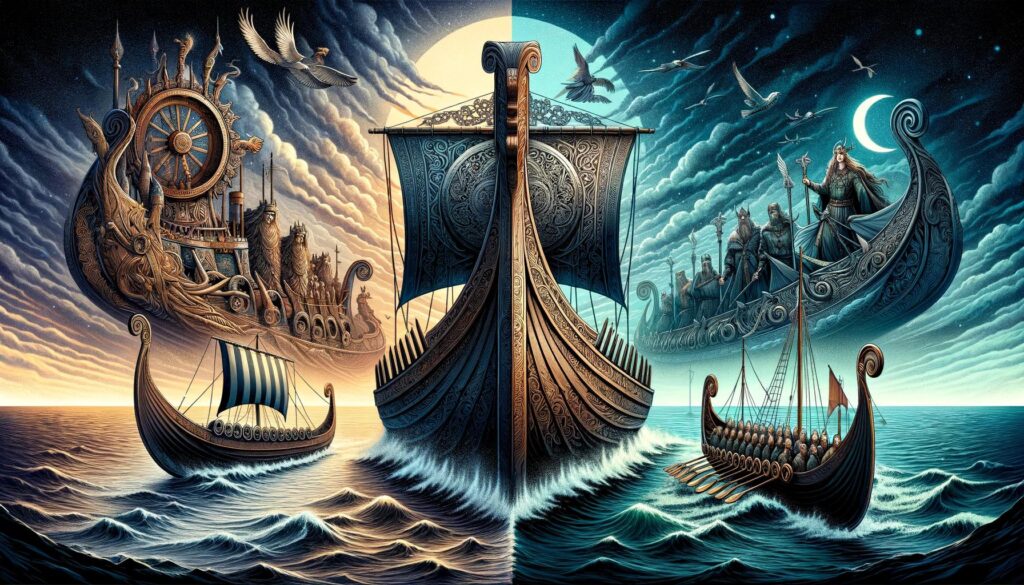Norse Mythology, Norse Symbols, Skidbladnir, Viking Ships
Skidbladnir and Viking Shipbuilding: How Mythology Inspires Reality
Introduction
The Vikings, seafaring warriors of the Norse world, are often celebrated for their prowess in shipbuilding. These remarkable vessels allowed them to explore new lands, raid distant shores, and establish trade routes throughout the medieval world. But what if I told you that the Vikings’ shipbuilding techniques were practical and inspired by their rich mythology? In this article, we will delve into the world of Viking shipbuilding, with a particular focus on the legendary Skidbladnir and how mythology played a significant role in shaping the construction of these iconic ships.
The Vikings and Their Ships
To understand the influence of mythology on Viking shipbuilding, we must first appreciate the importance of ships in their culture. The Vikings were an adventurous people who lived in the Scandinavian region during the Viking Age, roughly spanning from the late 8th century to the early 11th century. These seafarers relied heavily on their ships for transportation, exploration, trade, and warfare.
Viking ships were marvels of craftsmanship, characterized by their long, slender design and shallow draft. They were versatile vessels, capable of navigating both open seas and shallow rivers, thanks to their innovative construction techniques. The Vikings’ mastery of shipbuilding played a pivotal role in their ability to embark on epic voyages, from the discovery of Iceland to the exploration of North America, centuries before Christopher Columbus.
The Role of Mythology in Viking Culture
Skidbladnir: The Mythical Ship of Freyr
One of the most prominent examples of mythology’s impact on Viking shipbuilding is the legendary ship known as Skidbladnir. Skidbladnir was a magical ship said to have been created by the dwarven brothers Brokk and Sindri (also known as Eitri) as part of a competition with Loki. Its extraordinary qualities made it a symbol of power and wealth in Norse mythology.
Skidbladnir’s Magical Properties
Skidbladnir was renowned for its unique ability to fold into a compact size, making it incredibly portable. According to the myths, it could accommodate all the gods of Asgard while still being small enough to fit inside a pouch. This remarkable feature made Skidbladnir an ideal vessel for the gods to travel swiftly across land and sea, much like the Vikings’ own ships.
Skidbladnir’s Influence on Viking Ship Design
The tale of Skidbladnir undoubtedly left an imprint on the minds of Viking shipbuilders. The idea of a ship that could fold and be easily transported may have influenced the Vikings’ choice of materials and construction methods.
In practical terms, Viking ships were known for their collapsible masts and removable oars, allowing them to navigate both open waters and narrow rivers. This flexibility in design made their ships adaptable to various conditions and situations, much like the mythical Skidbladnir.
Viking Shipbuilding Techniques
Now that we’ve explored the mythological influence on Viking shipbuilding let’s delve into the practical aspects of how these remarkable vessels were constructed.
Materials
Viking ships were typically constructed using a combination of oak, pine, and other types of wood. Oak was favored for its strength and durability, while pine was used for the ship’s lighter elements, such as the mast and planking.
Design
The Vikings employed a clinker construction technique, also known as lapstrake, in which overlapping planks were fastened together with iron nails. This method resulted in a sturdy yet flexible hull that could withstand the rigors of the sea.
The longship, known as “Drakkar” in Old Norse, was one of the most iconic Viking ship designs. Its shallow draft allowed it to navigate shallow waters and make beach landings, a crucial advantage in raids and exploration.
Rigging and Sails
Viking ships had a single mast with a square sail, often made of wool or linen. These sails could be adjusted to catch the wind effectively, giving the ships impressive speed and maneuverability. The rigging allowed the Vikings to navigate both coastal waters and the open sea.
Iconic Dragon Heads
One of the distinctive features of Viking longships was their ornate prows adorned with intricately carved dragon heads. These menacing figures served both practical and symbolic purposes. They were thought to protect the ship from evil spirits and sea monsters while striking fear into potential adversaries’ hearts.
The Viking Longship and Skidbladnir’s Legacy
Summary
The Vikings’ shipbuilding prowess is a testament to their engineering ingenuity and maritime skills. While practicality was undoubtedly a driving force behind the construction of their longships, the influence of mythology cannot be underestimated. The legendary Skidbladnir, with its magical properties and portable design, served as a source of inspiration for Viking shipbuilders.
The combination of myth and reality in Viking shipbuilding created vessels that were not only efficient for their time but also iconic symbols of exploration and conquest. The legacy of the Viking longship, with its dragon heads and clinker construction, continues to capture the imagination of people around the world, reminding us of the enduring influence of mythology on the practical aspects of human civilization. So, the next time you see a replica of a Viking longship, remember that it carries with it the echoes of Skidbladnir, a ship born from the realm of gods and heroes but brought to life by the hands of skilled Norse shipbuilders.

